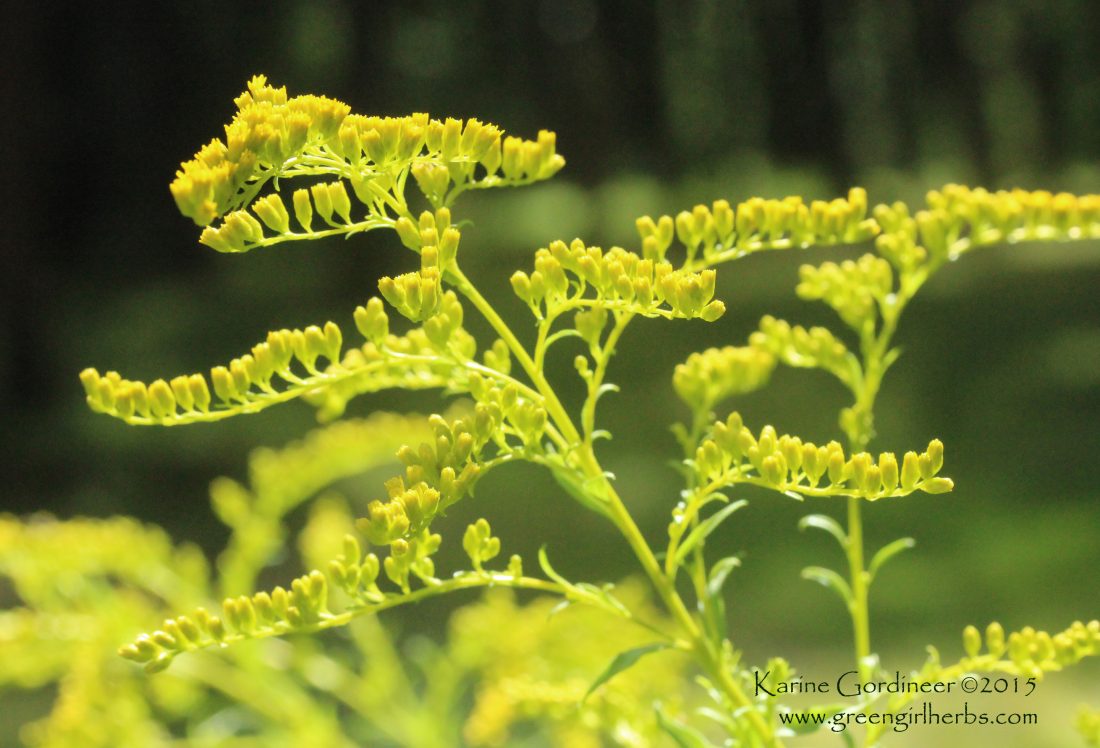
Goldenrod, fall allergies, and other fairytales
Nothing heralds the coming Autumn for me like the very beautiful and showy yellow flowers of Goldenrod (Solidago canadensis, Solidago spp.). Although, Goldenrod, in all her golden glory, is the scapegoat for fall allergies, it is actually the common Ragweed (Ambrosia artemisifolia) with its inconspicuous green inflorescence also blooming at this time that is usually to blame. Goldenrod has very little pollen and what pollen it does have is very dense and sticky in order to be carried off by insects that visit. Ragweed on the other hand, makes a profusion of pollen that is distributed on the wind. Solidago canadensis is a Native perennial that spreads rapidly through its rhizomes. Often found in dense stands, there are approximately 60 species of Goldenrod in the Northern Hemisphere found in all states except Hawaii, Louisiana, Georgia, South Carolina, and Florida. Goldenrod is also found in nearly all of the Canadian provinces. Goldenrod is found in moist meadows, near waterways, and prairies in locations with full or part sun. It ranges in height from 1 to 7 feet with bright flowers arranged in drooping panicles.
 Many Native American tribes utilized the Goldenrod plant for a variety of ills including the Iroquois who employed infusions of the roots and flowers for pain. The Potawatomi made a tea from the blossoms to bring down fevers. Other tribes used the plant topically to treat snakebite, and the root for burns. Indeed, Goldenrod is rich with medicinal healing powers and with its astringent qualities can be used to quell fall allergic reactions as well as cold and flu upper respiratory mucus and fevers. Goldenrod can be taken to help tune our immune systems for winter and as nature is so wise, she has arranged that Goldenrod is available for us just in time. Goldenrod is a friend to the urinary system and healing to the kidneys, coming to the aid of those suffering with urinary gravel or stones, and frequent urination. A tea can also be taken to prevent gravel, kidney stones, nephritis, and issues of the prostate. Goldenrod is an effective digestive and possesses anti-inflammatory qualities. As a cleansing herb, it is helpful in the treatment of arthritis. Goldenrod can be used as a tea or tincture and the seeds are an edible trailfood. All Goldenrods are safe to use and many can be used interchangeably.
Many Native American tribes utilized the Goldenrod plant for a variety of ills including the Iroquois who employed infusions of the roots and flowers for pain. The Potawatomi made a tea from the blossoms to bring down fevers. Other tribes used the plant topically to treat snakebite, and the root for burns. Indeed, Goldenrod is rich with medicinal healing powers and with its astringent qualities can be used to quell fall allergic reactions as well as cold and flu upper respiratory mucus and fevers. Goldenrod can be taken to help tune our immune systems for winter and as nature is so wise, she has arranged that Goldenrod is available for us just in time. Goldenrod is a friend to the urinary system and healing to the kidneys, coming to the aid of those suffering with urinary gravel or stones, and frequent urination. A tea can also be taken to prevent gravel, kidney stones, nephritis, and issues of the prostate. Goldenrod is an effective digestive and possesses anti-inflammatory qualities. As a cleansing herb, it is helpful in the treatment of arthritis. Goldenrod can be used as a tea or tincture and the seeds are an edible trailfood. All Goldenrods are safe to use and many can be used interchangeably.
Goldenrod is an important food source for native pollinators in the fall allowing them to store up food for the winter. As with all plants, Goldenrod also performs important functions for the land. As a phytoremediator, Goldenrod helps to stabilize the soil and revegetate disturbed areas. Goldenrod is a friend to both human, insects, animals, and Earth. Leaving areas to remain wild allows this important medicinal and other useful plants to show up. If you have a yard or field, consider leaving at least a part of it free from mowing and pruning, nature will thank you for it!



Paula S Tytlar
October 6, 2019 at 7:49 pmThx for thus very interesting information! Love and hugs!
Ramona Loggens
October 23, 2021 at 1:08 pmExcellent web site you’ve got here.. It’s hard to find quality writing like yours nowadays. I seriously appreciate people like you! Take care!!
Chuck Megown
October 27, 2021 at 2:04 pmVery good information. Lucky me I found your website by chance (stumbleupon). I’ve saved it for later!